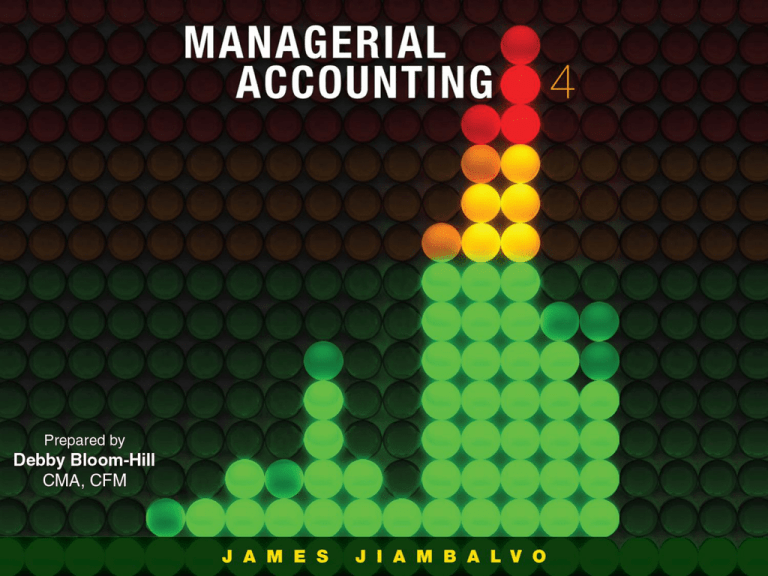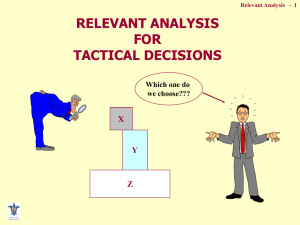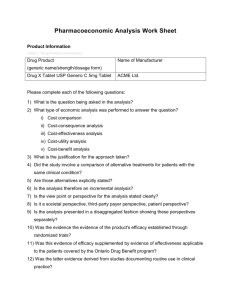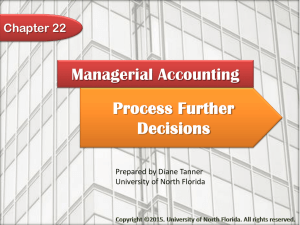
CHAPTER 7
Use of Cost Information in
Management Decision
Making
Slide 7-2
Incremental Analysis
Incremental Revenue
Additional revenue received by selecting one
alternative over another
Incremental Cost
Additional cost incurred by selecting one
alternative over another
Incremental Profit
Difference between incremental revenue and
incremental cost
Slide 7-3
Learning objective 1: Explain the role of incremental analysis (analysis of
incremental costs and revenues) in management decisions
Incremental Analysis
An alternative that yields an incremental
profit should be selected
Incremental costs are referred to as
relevant costs
Also called differential costs
Slide 7-4
Learning objective 1: Explain the role of incremental analysis (analysis of
incremental costs and revenues) in management decisions
Incremental Analysis Example
Slide 7-5
Learning objective 1: Explain the role of incremental analysis (analysis of
incremental costs and revenues) in management decisions
Incremental Analysis
Incremental Analysis can be extended
to more than two alternatives
Calculate profit for each alternative
The alternative with the highest profit
is the best alternative
Difference between its profit and the
profit of any other alternative is its
incremental profit
Slide 7-6
Learning objective 1: Explain the role of incremental analysis (analysis of
incremental costs and revenues) in management decisions
“What Does This Product Cost?”
Answer: Why do you want to know?
No single cost number is relevant for
all decisions
Must find incremental information
that is applicable to the decision
- Some costs will change due to the
decision, some will not
- Only costs that change are relevant
Slide 7-7
Learning objective 1: Explain the role of incremental analysis (analysis of
incremental costs and revenues) in management decisions
Analysis of Decisions Faced
by Managers
Three decisions that managers frequently
face:
1. Additional processing of a product
2. Make or buy a product
3. Drop a product line
Slide 7-8
Learning objective 1: Explain the role of incremental analysis (analysis of
incremental costs and revenues) in management decisions
Additional Processing of a
Product
Manufacturers must occasionally decide
whether to:
- Sell partially complete product, or
- Incur additional costs to complete
Costs incurred to date of decision on
partially complete product are not
relevant, i.e sunk costs.
Slide 7-9
Learning objective 1: Explain the role of incremental analysis (analysis of
incremental costs and revenues) in management decisions
Additional Processing Decision –
Bridge Computer Example
Summary of cost information
Slide 7-10
Learning objective 1: Explain the role of incremental analysis (analysis of
incremental costs and revenues) in management decisions
Additional Processing Decision –
Bridge Computer Example
Incremental analysis summary
Sell
Partially
Sell Fully
Complete Complete Incremental
Revenue
$500
$1,000
$500 a
Prior Production Costs
(800)
(800)
0
Additional Processing Costs
0
(400)
(400) b
Gain (loss) per unit
($300)
($200)
$100 c
a. Incremental revenue associated with alternative 2
b. Incremental cost associated with alternative 2
c. Incremental profit associated with alternative 2
Slide 7-11
Learning objective 1: Explain the role of incremental analysis (analysis of
incremental costs and revenues) in management decisions
Additional Processing Decision –
Bridge Computer Example
Incremental analysis summary
Incremental revenues are $500
Incremental costs are $400
Would you spend $400 to generate an
additional $500?
Answer: Yes, incremental profit is
$100
Slide 7-12
Learning objective 1: Explain the role of incremental analysis (analysis of
incremental costs and revenues) in management decisions
Additional Processing Decision
Slide 7-13
Learning objective 1: Explain the role of incremental analysis (analysis of
incremental costs and revenues) in management decisions
Make or Buy Decisions
Decision involves no incremental
revenues
Analysis concentrates solely on
incremental costs
Slide 7-14
Learning objective 1: Explain the role of incremental analysis (analysis of
incremental costs and revenues) in management decisions
Make-or-Buy Decisions – General
Refrigeration Example
Additional information:
If purchased, cost savings include $390,000 in
supervisory salaries and all variable costs.
Market value of production machinery is zero
Slide 7-15
Learning objective 1: Explain the role of incremental analysis (analysis of
incremental costs and revenues) in management decisions
Make-or-Buy Decisions – General
Refrigeration Example
Incremental cost analysis – 3 column format
Slide 7-16
Learning objective 1: Explain the role of incremental analysis (analysis of
incremental costs and revenues) in management decisions
Make-or-Buy Decisions – General
Refrigeration Example
Incremental cost analysis - single column format
Slide 7-17
Learning objective 1: Explain the role of incremental analysis (analysis of
incremental costs and revenues) in management decisions
Make-or-Buy Decisions
Slide 7-18
Learning objective 1: Explain the role of incremental analysis (analysis of
incremental costs and revenues) in management decisions
Make-or-Buy Decisions – General
Refrigeration Example
Incremental cost analysis with opportunity
costs
Slide 7-19
Learning objective 1: Explain the role of incremental analysis
(analysis of incremental costs and revenues) in management decisions
Evelyn’s farm has two alternatives for the sale of
100 pounds of cucumbers
1. Sell as-is (raw) for $0.79 per pound
2. Pickle (process) and sell for $6.99 per pound
Additional pickling costs per pound: materials
$1.50; labor $2.00
Should Evelyn sell cucumbers or pickles? Pickles
Cucumbers
Revenue
100 lbs X $0.79
100 lbs X $6.99
Incremental cost
100 lbs X $1.50
100 lbs X $2.00
Incremental profit
Slide 7-20
Pickles
Incremental
$79
$699
$620
(150)
(200)
(150)
(200)
$270
0
Learning objective 1: Explain the role of incremental analysis (analysis of
incremental costs and revenues) in management decisions
Drop a Product Line
Analysis involves calculating the change
in income that will result from dropping
the product line:
If income increases, the product line
should be dropped
If income decreases, the product line
should not be dropped
Note: Allocated costs are not relevant
Slide 7-21
Learning objective 1: Explain the role of incremental analysis (analysis of
incremental costs and revenues) in management decisions
Dropping a Product Line –
Mercer Hardware Example
Profit calculation with three product lines
Mercer Hardware
Product Line Income Statement
For the Year Ended December 31, 2006
Sales
Traceable costs:
Cost of goods sold
Other variable costs
Direct fixed costs
Non-traceable costs
Company fixed costs
Division net income
Slide 7-22
Tools
$120,000
Hardware
Supplies
$200,000
Garden
Supplies
$80,000
Total
3 products
$400,000
(81,000)
(2,000)
(8,000)
(90,000)
(4,000)
(5,000)
(60,000)
(1,000)
(3,500)
(231,000)
(7,000)
(16,500)
(24,000)
$5,000
(40,000)
$61,000
(16,000)
($500)
(80,000)
$65,500
Learning objective 1: Explain the role of incremental analysis (analysis of
incremental costs and revenues) in management decisions
Dropping a Product Line –
Mercer Hardware Example
Profit calculation with two product lines
Mercer Hardware
Product Line Income Statement
For the Year Ended December 31, 2006
Sales
Traceable costs:
Cost of goods sold
Other variable costs
Direct fixed costs
Non-traceable costs
Company fixed costs
Division net income
Tools
$120,000
Hardware
Supplies
$200,000
Total
2 products
$320,000
Total
3 products
$400,000
(81,000)
(2,000)
(8,000)
(90,000)
(4,000)
(5,000)
(171,000)
(6,000)
(13,000)
(231,000)
(7,000)
(16,500)
(30,000)
($1,000)
(50,000)
$51,000
(80,000)
$50,000
(80,000)
$65,500
Total company fixed costs are $80,000 whether 2 or 3 products are sold
Slide 7-23
Learning objective 1: Explain the role of incremental analysis (analysis of
incremental costs and revenues) in management decisions
Dropping a Product Line –
Mercer Hardware Example
Slide 7-24
Learning objective 1: Explain the role of incremental analysis (analysis of
incremental costs and revenues) in management decisions
Beware of the Cost Allocation
Death Spiral
When dropping a product line
- Common fixed costs are not incremental
- Common fixed cost allocation is spread
among remaining product lines
Management must understand and
remember this impact when making
decisions
Slide 7-25
Learning objective 1: Explain the role of incremental analysis
(analysis of incremental costs and revenues) in management decisions
Terminology Summary
Sunk costs
- Costs already incurred
- Never incremental or relevant
i.e. Do not differ between alternatives
Avoidable costs
- Costs avoided if an action is undertaken
- Always incremental and relevant
Opportunity costs
- Benefits foregone by selecting one alternative
over another
- Always incremental and relevant
Slide 7-26
Learning objective 2: Define sunk cost, avoidable cost, and opportunity cost, and
understand how to use these concepts in analyzing decisions
Which of the following is often not a
differential cost?
a. Material
b. Labor
c. Variable overhead
d. Fixed overhead
Answer: d
Fixed overhead
Slide 7-27
Learning objective 2: Define sunk cost, avoidable cost, and opportunity cost, and
understand how to use these concepts in analyzing decisions
Opportunity costs are:
a.
b.
c.
d.
Never incremental costs
Always incremental costs
Sometimes sunk costs
Never avoidable costs
Answer: b
Always incremental costs
Slide 7-28
Learning objective 2: Define sunk cost, avoidable cost, and opportunity cost, and
understand how to use these concepts in analyzing decisions
Which of the following costs should not be
taken into consideration when making a
decision?
a. Opportunity costs
b. Sunk costs
c. Relevant costs
d. Differential costs
Answer: b
Sunk costs
Slide 7-29
Learning objective 2: Define sunk cost, avoidable cost, and opportunity cost, and
understand how to use these concepts in analyzing decisions
Decisions Involving Joint Costs
Joint Products
- When two or more products always result from
common inputs
Joint Costs
- Costs of the common inputs
Split-Off Point
- Stage of production in which individual
products are identified
- Product may undergo further processing with
additional costs
Slide 7-30
Learning objective 3: Analyze
decisions involving joint costs
Joint Products Example
Slide 7-31
Learning objective 3: Analyze
decisions involving joint costs
Allocation of Joint Costs
Cost of the common inputs
- Allocated to the joint products for
financial reporting purposes
- Can mislead managers about product
line profitability
Joint cost information is
- Irrelevant to individual joint product
decisions
- It is not an incremental cost
Slide 7-32
Learning objective 3: Analyze
decisions involving joint costs
Joint Cost Allocation Methods
Relative sales value method
Cost allocated to product A:
Sales value A / Total sales value x Joint cost
Physical quantity method
Cost allocated to product A:
Physical measure A / Total physical measure x
Joint cost
Slide 7-33
Learning objective 3: Analyze
decisions involving joint costs
Joint costs $1,000
Economy grade:
Quantity = 1,ooo pounds
Sales price = $0.10 per pound
Superior grade
Quantity = 4,000 pounds
Sales price = $0.30 per pound
Allocate joint costs using physical measure.
Weight
Economy
1,000
Superior
4,000
Total
5,000
Slide 7-34
Percentage
Allocation
1,000 / 5,000= 20% X $1, 000 =
$200.00
4,000 / 5,000 = 80% X $1, 000 =
800.00
$1,000.00
Learning objective 3: Analyze
decisions involving joint costs
Joint costs $1,000
Economy grade
Quantity = 1,ooo pounds
Sales price = $0.10 per pound
Superior grade
Quantity = 4,000 pounds
Sales price = $0.30 per pound
Allocate joint costs using relative sales value.
Sales Value
Percentage
Allocation
Economy 1,ooo X $0.10 = $100.00 $100 / $1,300 = 8% X $1, 000 =
$77
Superior 4,ooo X $0.30 = 1,200.00 $1,200 / $1,300 = 92% X $1, 000 =
$923
Total
$1,300.00
$1,000
Slide 7-35
Learning objective 3: Analyze
decisions involving joint costs
Additional Processing Decisions
and Joint Costs
Joint costs not relevant to decisions
made after the split-off point
Joint costs incurred prior to the splitoff point are sunk costs
Decisions should be based on
incremental analysis
Slide 7-36
Learning objective 3: Analyze
decisions involving joint costs
The joint costs incurred in a joint
product situation:
a. Are incurred before the split-off
point
b. Are incurred after the split-off point
c. Should only be allocated based on
physical attributes
d. Should never be allocated
Answer: a
Are incurred before the split-off point
Slide 7-37
Learning objective 3: Analyze
decisions involving joint costs
Qualitative Considerations in
Decision Analysis
Many decisions have one or more features
that are difficult to quantify but should be
considered
Examples include, but are not limited to:
- Swings in economy
- Loss of control
- Quality of product
- Quality of service
- Company morale
Slide 7-38
Learning objective 4: Discuss the importance of qualitative
considerations to management decisions
Qualitative Considerations in
Decision Analysis
Slide 7-39
Learning objective 4: Discuss the importance of qualitative
considerations to management decisions
Qualitative Factors
Slide 7-40
Learning objective 4: Discuss the importance of qualitative
considerations to management decisions
The Five-Step Process of the
Theory of Constraints
1. Identify the Binding Constraint
2. Optimize Use of the Constraint
3. Subordinate Everything Else to the
Constraint
4. Break the Constraint
5. Identify a New Binding Constraint
Slide 7-41
Learning objective A1: Understand the five-step approach to
the Theory of Constraints (TOC)
Optimize Use of the Constraint
Slide 7-42
Learning objective A1: Understand the five-step approach to
the Theory of Constraints (TOC)
Overproduction in NonBottleneck Departments
Slide 7-43
Learning objective A1: Understand the five-step approach to
the Theory of Constraints (TOC)
Copyright
© 2010 John Wiley & Sons, Inc. All rights
reserved. Reproduction or translation of this
work beyond that permitted in Section 117 of
the 1976 United States Copyright Act without
the express written permission of the
copyright owner is unlawful. Request for
further information should be addressed to the
Permissions Department, John Wiley & Sons,
Inc. The purchaser may make back-up copies
for his/her own use only and not for
distribution or resale. The Publisher assumes
no responsibility for errors, omissions, or
damages, caused by the use of these programs
or from the use of the information contained
herein.
Slide 7-44





